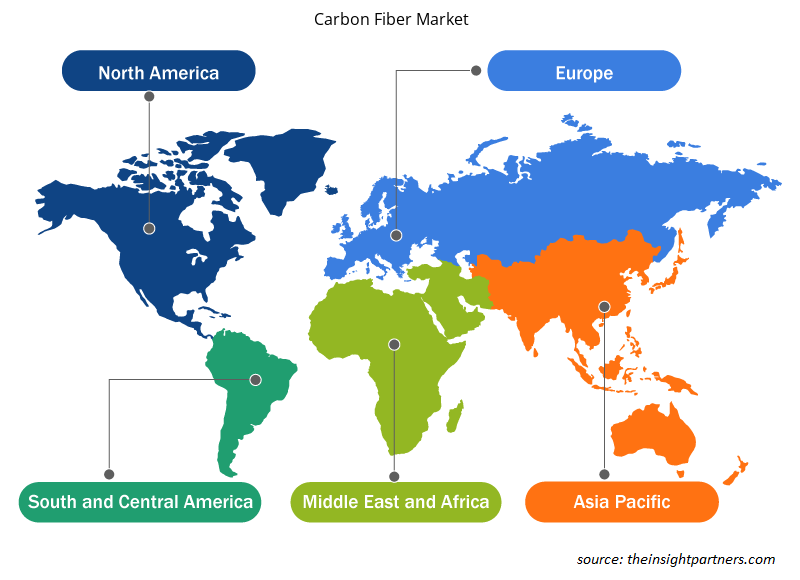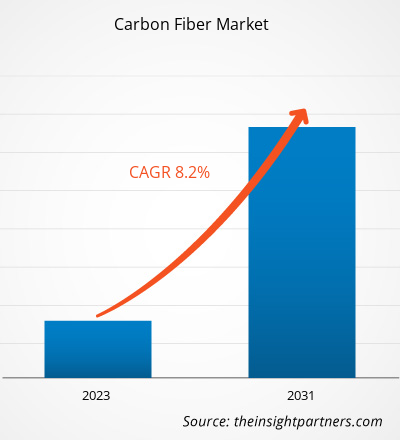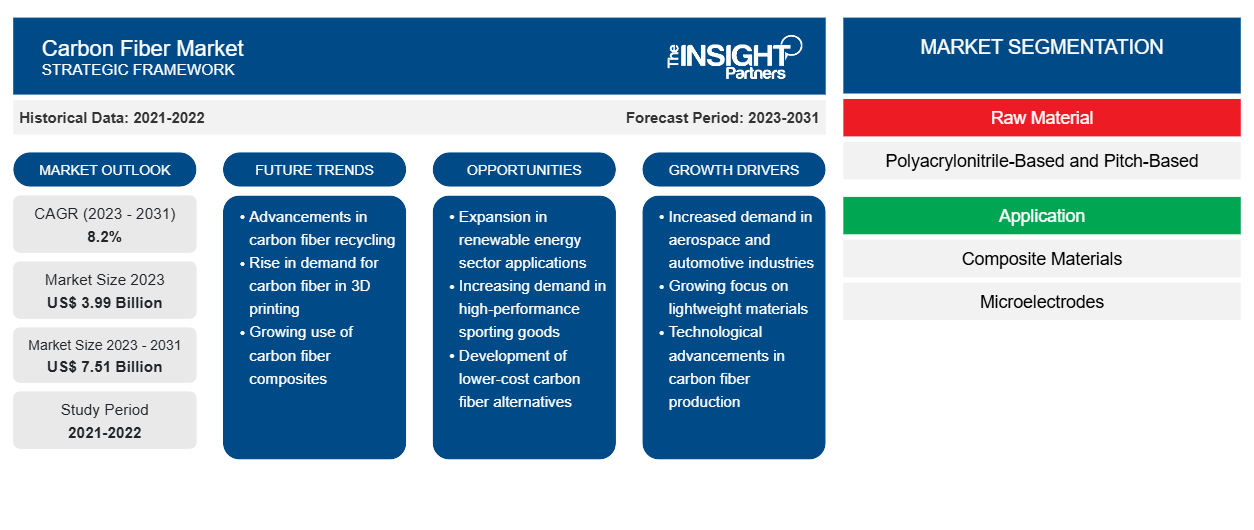碳纤维市场规模预计将从 2023 年的 39.9 亿美元增至 2031 年的 75.1 亿美元。预计 2023-2031 年期间市场复合年增长率将达到 8.2%。航空航天、汽车、运动器材和工业领域不断增长的需求可能会在未来带来新的碳纤维市场趋势。
碳纤维市场分析
碳纤维具有出色的机械强度、刚度、耐热性和耐化学性。它们比钢或铝轻得多,但强度却相对较高。这使得碳纤维成为航空航天、汽车、运动器材和工业领域等减重至关重要的应用中的抢手材料。随着各行各业越来越多地采用碳纤维复合材料来满足其对轻质、耐用和节能材料的需求,碳纤维市场预计将继续增长。碳纤维制造工艺的技术进步和具有成本效益的生产技术的开发也可能有助于未来几年的市场扩张。
碳纤维市场概况
汽车制造商寻求创新和高质量的材料来生产具有高机械强度和抗拉强度的轻型汽车部件。碳纤维被认为是生产轻型汽车部件最合适的材料之一。此外,碳纤维增强复合材料被用作替代钢和铝部件的必需材料,因为钢和铝部件重量较重,导致燃油效率降低。碳纤维在汽车工业中的使用提高了燃油效率,从而节约了能源并最大限度地减少了二氧化碳排放。领先的汽车制造商正在使用碳纤维来制造零部件。例如,空客 A350 单元由 52% 的碳纤维增强聚合物 (CFRP) 组成,而宝马 i3 单元的底盘主要是 CFRP。
定制此报告以满足您的需求
您可以免费定制任何报告,包括本报告的部分内容、国家级分析、Excel 数据包,以及为初创企业和大学提供优惠和折扣
-
获取此报告的关键市场趋势。这个免费样品将包括数据分析,从市场趋势到估计和预测。
碳纤维市场区域洞察
Insight Partners 的分析师已详尽解释了预测期内影响碳纤维市场的区域趋势和因素。本节还讨论了北美、欧洲、亚太地区、中东和非洲以及南美和中美洲的碳纤维市场细分和地理位置。

- 获取碳纤维市场的区域特定数据
碳纤维市场报告范围
| 报告属性 | 细节 |
|---|---|
| 2023 年的市场规模 | 39.9 亿美元 |
| 2031 年市场规模 | 75.1亿美元 |
| 全球复合年增长率(2023 - 2031)CAGR (2023 - 2031) | 8.2% |
| 史料 | 2021-2022 |
| 预测期 | 2023-2031 |
| 涵盖的领域 |
按原材料
|
| 覆盖地区和国家 |
北美
|
| 市场领导者和主要公司简介 |
|
碳纤维市场参与者密度:了解其对业务动态的影响
碳纤维市场正在快速增长,这得益于最终用户需求的不断增长,而这些需求又源于消费者偏好的不断变化、技术进步以及对产品优势的认识不断提高等因素。随着需求的增加,企业正在扩大其产品范围,进行创新以满足消费者的需求,并利用新兴趋势,从而进一步推动市场增长。
市场参与者密度是指在特定市场或行业内运营的企业或公司的分布情况。它表明在给定市场空间中,相对于其规模或总市场价值,有多少竞争对手(市场参与者)存在。
在碳纤维市场运营的主要公司有:
- SGL 碳素公司
- DowAksa先进复合材料工业有限公司
- 台塑股份有限公司
- 赫氏公司
- 晓星先进材料公司
- 吴羽公司
免责声明:上面列出的公司没有按照任何特定顺序排列。

- 了解碳纤维市场顶级关键参与者概况
碳纤维市场新闻及最新发展
碳纤维市场的评估是通过收集一手和二手研究后的定性和定量数据进行的,其中包括重要的公司出版物、协会数据和数据库。以下是碳纤维市场的发展列表:
- 东丽工业公司今天宣布,该公司已开发出 TORAYCA T1200 碳纤维,其强度为 1,160 千磅/平方英寸 (Ksi),为世界最高。这一新产品将通过减轻碳纤维增强塑料材料的重量,推动我们减少环境足迹。这种纤维还为强度驱动的应用开辟了新的性能前沿。其潜在应用范围从航空结构和国防到替代能源和消费品。(来源:东丽先进复合材料,新闻稿,2023 年)
- SGL Carbon 将在 2023 年 JEC World 上展示一款新型 50k 碳纤维。新型 SIGRAFIL C T50-4.9/235 碳纤维将满足常见压力容器设计的高强度要求,并具有高伸长率。它还能够在需要高强度和伸长率的细分市场中进一步应用。(来源:SGL Carbon,新闻稿,2023 年)
碳纤维市场报告范围和交付成果
“碳纤维市场规模和预测(2021-2031)”报告对以下领域进行了详细的市场分析:
- 范围内涵盖的所有主要细分市场的全球、区域和国家层面的市场规模和预测
- 市场动态,如驱动因素、限制因素和关键机遇
- 未来的主要趋势
- 详细的波特五力分析和 SWOT 分析
- 全球和区域市场分析涵盖关键市场趋势、主要参与者、法规和最新市场发展
- 行业格局和竞争分析,涵盖市场集中度、热点图分析、知名参与者和最新发展
- 详细的公司简介
- 历史分析(2 年)、基准年、预测(7 年)及复合年增长率
- PEST和SWOT分析
- 市场规模、价值/数量 - 全球、区域、国家
- 行业和竞争格局
- Excel 数据集
近期报告
相关报告
客户评价
购买理由
- 明智的决策
- 了解市场动态
- 竞争分析
- 客户洞察
- 市场预测
- 风险规避
- 战略规划
- 投资论证
- 识别新兴市场
- 优化营销策略
- 提升运营效率
- 顺应监管趋势























 获取免费样品 - 碳纤维市场
获取免费样品 - 碳纤维市场